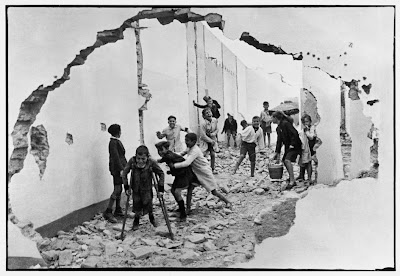...Henri Cartier-Bresson once stated on behalf of himself, Robert Capa, and Brassaï, “Whatever we have done, Kertész did first.”
Distortion #70
I wanted to do something my way—with my conception—without complications. I took the dancers along and photographed them on a children’s playground dancing. Some children were playing hide-and-seek and the dancers started to mix with the children. Look at the adoration of the children in the picture. This was a fantastic moment captured in a photo. The dancer, which is the glamour, and the children. the publicity manager sent the photos over to Life magazine. They came back to one and a half years later: “We do not find a place for using them.”
- André Kertész, Kertész on Kertész
Distortion #40
Distortion #140
Distortion #41
One day my mother said, “If you want to go to Paris, go.” This was a great moment in my life. It was 1925. Arriving late at night, I and two other Hungarian boys took a room in a hotel. We were very tired, but next morning I looked out of the window and say my first subject. I knew no one in Paris, but I soon made friends.
- André Kertész, Kertész on Kertész
Distortion #172
Distortion #78
Distortion #23
Distortion #80
A Hungarian friend of mine introduced me to the editor of the magazine “Le Sourire,” a very French sort of magazine–satiric, risqué. Many artists worked for this publication. They had never published photos before. The editor asked me to do something. I bought two distorting mirrors in the flea market–the kind of thing you find in amusement parks. With existing light and an old lens invented by Hugo Meyer, I achieved amusing impressions. Some images like sculptures, others grotesque and frightening. I took about 140 photographs in a month, working two or three times a week. “Le Sourire” published a couple of them, and we planned a book, but it had to wait forty years to be published–but that is another story.
- André Kertész, Kertész on Kertész

Robert Doisneau and André Kertész in Arles, France, 1975 © Wolfgang H. Wögerer



































